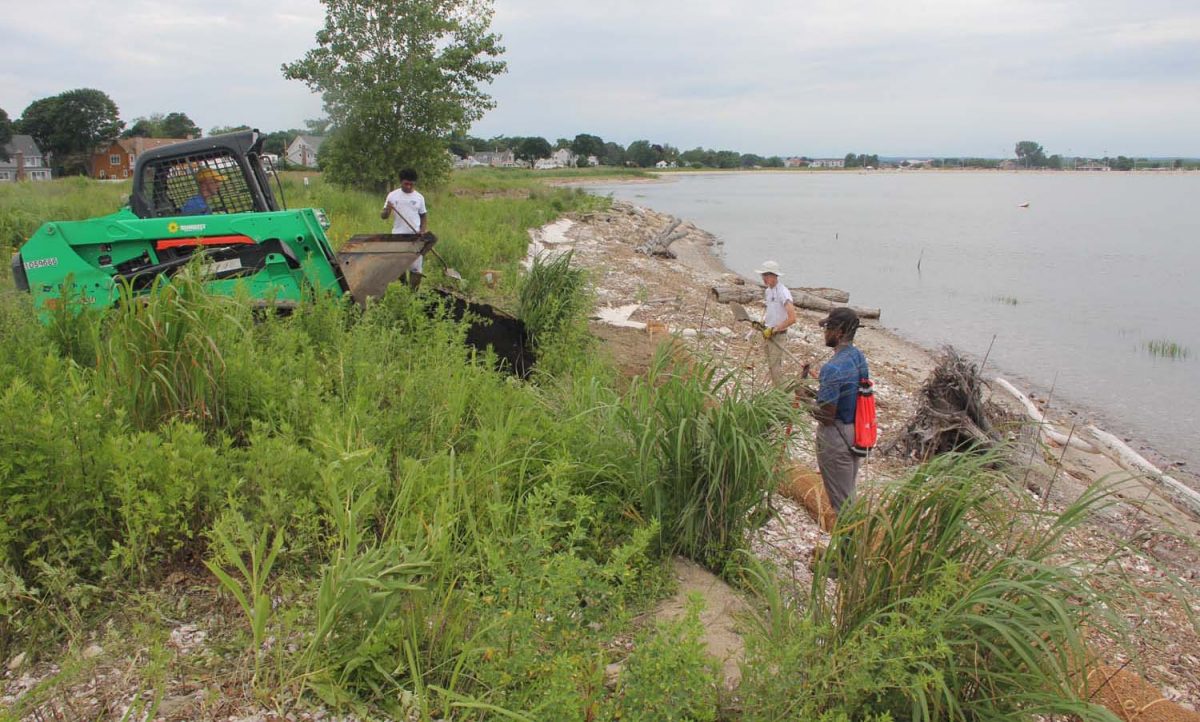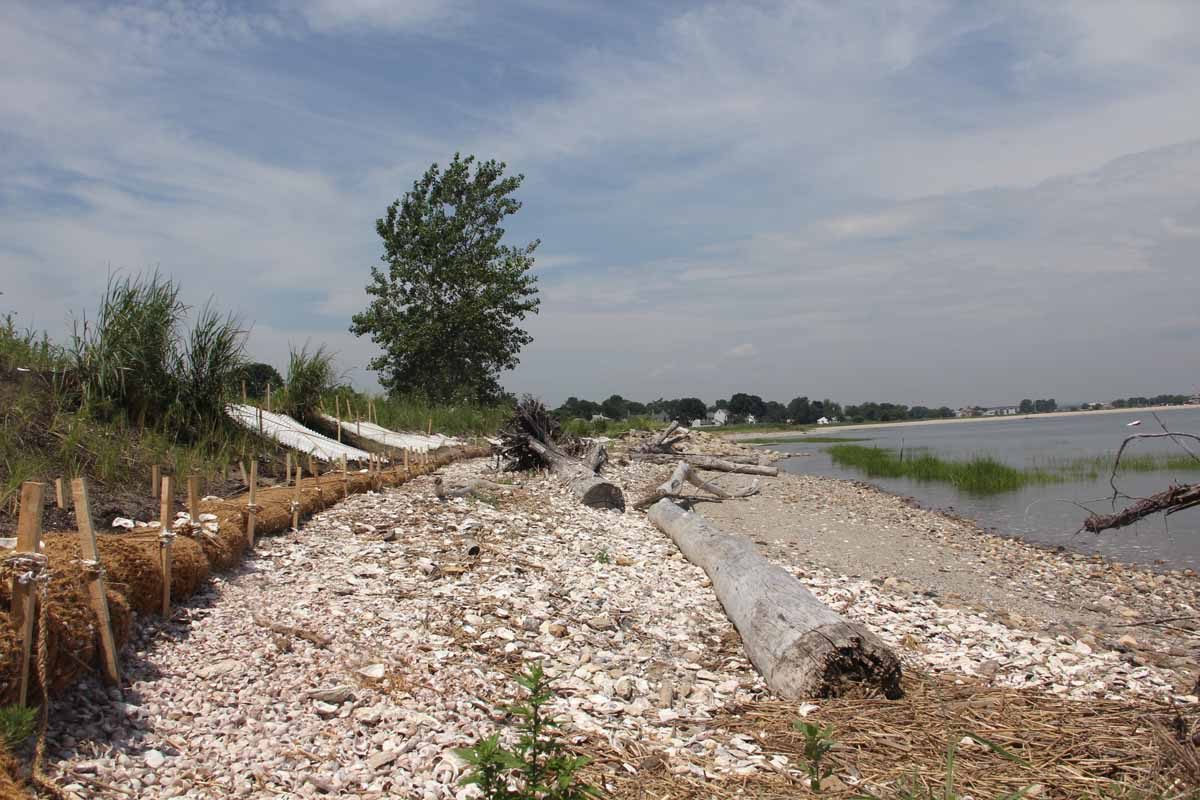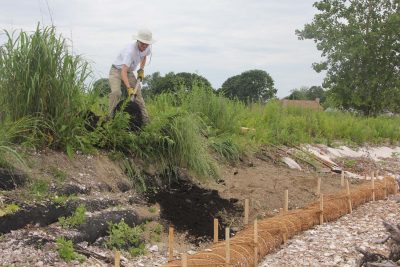
Story and photos by Judy Benson
For many college students, the summer after freshman year means heading home for jobs waiting tables, working at youth recreation programs or scooping ice cream at the beach snack bar.
But after completing his first year at the University of Delaware, Sam Koeck came home to Connecticut to the kind of paid internship usually afforded only to students further along in college, when they’ve already taken several upper-level courses in their major. A resident of Fairfield, Koeck is getting the chance to develop skills and real-world experience uniquely relevant to his double major in materials engineering and marine science at nearby Stratford Point, a Long Island Sound site serving as a laboratory for shoreline restoration. At the same time, he is enabling two Sea Grant programs –Delaware and Connecticut – to partner on a project that could benefit both states.
“Sam is just starting his academic career, so I hope this gives him the exposure he needs to help him see a path forward,” said Chris Hauser, associate director of Delaware Sea Grant. “We’re really excited about the skills that Sam will gain and how he can use them.”
Nancy Balcom, associate director of Connecticut Sea Grant, said the chance to work with another Sea Grant to jointly support Koeck – each program is providing half of his $5,000 summer salary – was a great opportunity.
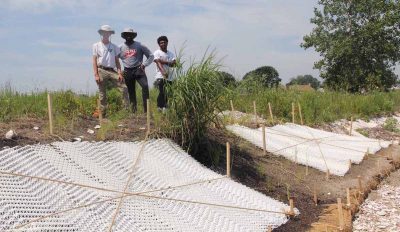
“We were so pleased that Chris reached out to see if we wanted to partner with Delaware Sea Grant in supporting Sam’s participation,” she said.
A unique set of circumstances led to the placement of Koeck at Stratford Point, where decades of hard use as a shooting range were followed by several projects to remediate pollution, rebuild the degraded marsh and stabilize dunes against erosion from storm surge. Now overseen by Audubon Connecticut, the site was well known to Hauser from work he did there for a private environmental engineering firm before taking the Delaware Sea Grant job a year ago. During that project, he became acquainted with Jennifer Mattei, biology professor at Sacred Heart University in Fairfield who’s been doing restoration work there including placement of hollow concrete balls offshore to create an oyster reef to buffer wave action.
“I’ve been working here since 2011,” Mattei said, as she led visitors on a tour of the site to explain elements of the various projects. These range from massive tree trunks anchored to the shore to tons of oyster shell deposited on the sand to an unsuccessful attempt to use plastic netting to hold up the steep bank of the dunes.
“Restoration projects take much more than two months, so after this summer Sam’s going to have to come back here to get data,” Mattei said.
Last fall, Koeck first heard about the Stratford Point project after Hauser spoke to one of his classes at UD. Koeck told him after the class that he was from a neighboring town in Connecticut, and that he’d be interested in working there. Once Hauser contacted Mattei and Connecticut Sea Grant, the rest fell into place.
“Environmental literacy and workforce development are essential to what we do at Sea Grant,” Hauser said. “We all agreed it would be worthwhile.”
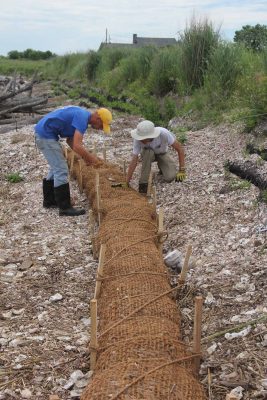
Stratford Point, a peninsula with 28 acres of upland meadows and 12 acres of shallow intertidal areas, was the first project in New England where living shoreline techniques were applied, Hauser noted. Living shorelines use natural elements like tree trunks and oyster reefs to buttress vulnerable coastal areas instead of concrete sea walls or stone jetties that don’t enhance wildlife habitat and can cause erosion in adjacent areas.
“This is the largest living shoreline in New England,” he added.
Thus far at the site, Koeck has helped place a 70-foot log made of biodegradable coconut fiber netting filled with oyster shell along the edge of the dunes, supplanting the plastic version breaking up under the effects of sunlight. Then he helped shovel dozens of cubic yards of compost and sand over the coconut-and-shell log, and planted native cord grass, foxtail and American beach grass. For much of the time, he’s been working alongside two Sacred Heart seniors working for Mattei for the summer, Adrian Nelson and Jeffrey Young.
“Now we’re just looking to make sure everything we planted stays in place and starts growing,” Koeck said.
He also helped place sheets of white mesh made from potato starch, a relatively new plastic replacement, to hold the new soil in place while the plants grow in.
“It should biodegrade after 10 years, and the plants will come up through it,” Koeck said.
His summer job, he said, is teaching him lessons directly relevant to how materials engineering and marine science intersect. It’s also personally as well as professionally satisfying.
“It makes me feel good knowing that this is helping advance restoration,” he said. “I feel responsible for this site, even though it wasn’t me or my relatives who were responsible (for the past degradation).”
Hauser said the Stratford Point project will help inform future work at other shoreline sites, including many in Delaware where Koeck could one day be applying his skills.
“We have the lowest average elevation of any state, so sea level rise is a big concern,” Hauser said. “We really need to develop solutions to the effects of climate change, and we’ll need new materials and new approaches.”
Balcom said Connecticut and Connecticut Sea Grant will benefit, too.
“The potential benefits from our small piece of this project are numerous,” she said. “Sam gains hands-on experience in applying classroom learning to help solve a real problem, working with two professional mentors (Hauser and Mattei). New techniques using biodegradable materials to help stabilize and protect the shoreline are being tested, potentially replacing the use of plastic in the future. That means the environment wins as well. And it’s always great to find a common interest or need around which we can partner with another Sea Grant program and amplify the outcomes.”
Judy Benson is the communications coordinator at Connecticut Sea Grant.

